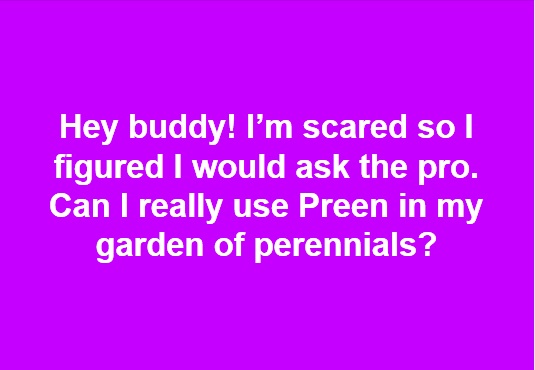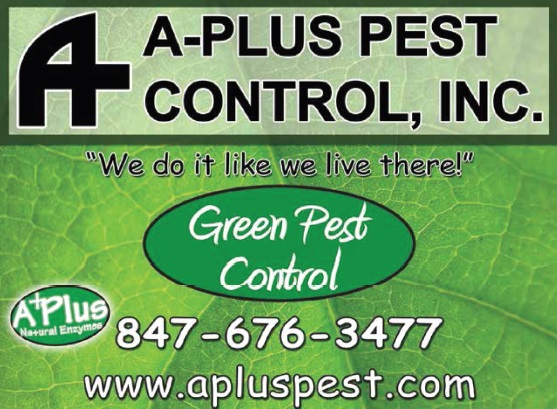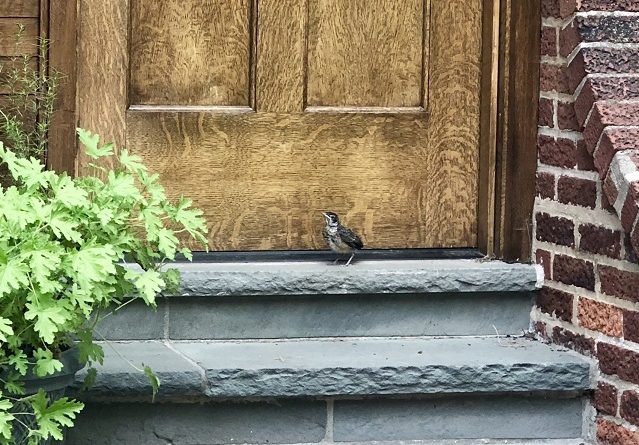Garden Questions, Answers and Stories
This showed up on my Facebook page the other day:

(May 27, 2018) I don’t know about anybody else, but for me, that’s not a simple question. And I don’t have a simple answer. So I thought I might spend a few minutes today going down the rabbit hole of garden “remedies” and their use.
There are a number of questions I would ask, starting with
What is the problem that you’re trying to solve?
Unfortunately, at this point, I have only the above graphic. I asked the person to come on the show and explain the issue but that probably won’t happen. So, I will have to be pretty general in my response.
Let’s start with some definitions. I realized the other day while talking to a friend that there are people who have never heard of the product “Preen®.” Home Guides at SFGate.com has a fairly simple description.
The Preen brand refers to a line of garden, yard and turf weed-control products for the home. Except for Preen Vegetable Garden Organic Weed Preventer, which contains 100 percent corn gluten meal, the products contain herbicidal chemicals in varying combinations and strengths. Preen’s weed and feed product also includes fertilizer.
They continue, listing what are called “active ingredients.”
The active ingredient in Preen Garden Weed Preventer, Weed Preventer Plus Plant Food and Preen Mulch Plus is trifluralin, used to control broadleaf weeds. Although rated as having low toxicity to humans, this herbicide is highly toxic to aquatic wildlife and should not be applied so heavily that runoff occurs. Both weed preventers contain 1.47 percent trifluralin, and Mulch Plus has 0.0032 percent. Preen Mulch Plus also contains isoxaben, which kills broadleaf weeds. Weed Preventer Plus Plant Food provides 9 percent nitrogen, 12 percent phosphate, 9 percent potash and 6.5 percent sulfur, along with 8 percent chlorine.
Are you still with me? As you can see, it’s not as easy as saying, “I want to use Preen in my yard.” If you go to the Preen website, you will see that they have a number of products. In the category of “flowers, trees and shrubs” alone, you can choose from “Weed Preventers,” “Weed Preventers With Plant Food” (aka “weed n’ feed”), and “Mulches With Weed Preventer.”
So let’s say you’re going with what some folks might call “classic” Preen, which is a weed preventer. If you click on that link, you have the option of getting more information from their “Quick Links”:
Application
FAQ
Weeds Controlled
Available Sizes
Reviews
Also available are these links:
SDS stands for Safety Data Sheet. Before 2012, you might have encountered something called the MSDS, or Material Safety Data Sheet. To understand how one changed to the other, click on this link. Frankly, Scarlett, I don’t have the time to go into it. Let’s just say that, for your purposes, they’re roughly the same thing. The product label is very important, too, simply for the sake of transparency.
Let’s start with the FAQ, or Frequently Asked Questions, section. Not counting the question about coupons and rebates, there are 61 questions. No fooling. The first question, after the one about coupons, is the most important:
What is the active ingredient in Preen® Garden Weed Preventer?
In my opinion, that’s the most important question, which is why it is listed first. If you don’t know the active ingredient of a garden product, you know pretty much nothing.
In this case, the answer is 1.47% Trifluralin (Treflan). Wikipedia says that Trifluralin is
a commonly used pre-emergence herbicide. With about 14 million pounds used in the United States in 2001, it is one of the most widely used herbicides.[2] Trifluralin is generally applied to the soil to provide control of a variety of annual grass and broadleaf weed species. It inhibits root development by interrupting mitosis, and thus can control weeds as they germinate.[3]
Trifluralin has been banned in the European Union since 20 March 2008, primarily due to high toxicity to aquatic life.[4]
Oops. Well, it’s not the first time that a pesticide that is used in the United States has been banned in Europe. You know, Precautionary Principle and all.
Thus, is it safe to use Preen (Trifluralin) in the garden? Well, that’s a relative question, folks. Obviously, the U.S. is okay with it and the European Union not so much. So let’s look at some more information about the chemical. The Trifluralin Pesticide Fact Sheet Prepared for the U.S. Department of Agriculture, Forest Service by Information Ventures, Inc., notes that
Trifluralin is practically nontoxic to birds when fed the chemical on both an acute and subacute basis. It did not impair reproduction in birds at dietary exposures below 50 ppm [parts per million]. Trifluralin is practically nontoxic to mammals. It is of low acute toxicity to honeybees.
So far, so good. But not so much when it comes to aquatic species:
Trifluralin is highly toxic to cold- and warm-water fish and to aquatic invertebrate animals. It is very highly toxic to amphibians (tadpoles). It has not been tested for effects on estuarine and marine animals. It may build up (bioaccumulate) in fish exposed to trifluralin in water at low levels; but in one test it was eliminated from edible fish tissues 7 days after exposure ended. Trifluralin affected the survival of minnows at chronic exposures as low as 5.1 ppb; and affected the survival of water fleas at chronic exposures as low as 7.2 ppb.
The LC50 (lethal concentration that causes death, resulting from a single or limited exposure, in 50 percent of the treated animals) for tadpoles is 0.1 ppm–one tenth of one part per million. And Extoxnet, the Extension Toxicology Network, has good and bad news:
[I]ts strong adsorption to soil and the usual practice of incorporating trifluralin into the soil at the time of application may prevent exposure of fish to this herbicide. Run-off from fields should be avoided. Contamination of open waters during mixing and loading operations by rinseate from the cleaning of application equipment or by accidental spills should be avoided.
So, will Preen harm you? No. Will it harm your pets? Probably not. Birds? No. Fish? Yes. Insects and soil organisms? Yes, some. In some (many?) circles, this is considered a fairly benign pesticide. Which is why the signal word on the Preen label reads “CAUTION.” That is the lowest level of toxicity, set by the EPA. According to the National Pesticide Information Center,
CAUTION means the pesticide product is slightly toxic if eaten, absorbed through the skin, inhaled, or it causes slight eye or skin irritation.
WARNING indicates the pesticide product is moderately toxic if eaten, absorbed through the skin, inhaled, or it causes moderate eye or skin irritation.
DANGER means that the pesticide product is highly toxic by at least one route of exposure. It may be corrosive, causing irreversible damage to the skin or eyes. Alternatively, it may be highly toxic if eaten, absorbed through the skin, or inhaled. If this is the case, then the word “POISON” must also be included in red letters on the front panel of the product label.
By the way, you also need to know how to use it. One of the FAQs asks
What weeds does Preen® Garden Weed Preventer kill?
None. Preen ® Garden Weed Preventer helps to prevent germination of seeds from the list of weeds shown on the label for up to 12 weeks per application. It does not kill or inhibit existing weeds in any way.
So if you’re trying to get rid of existing dandelions or Creeping Charlie, you’re reaching for the wrong product. There’s a reason that this type of product is called a preemergent herbicide. Its job is to prevent seeds from germinating properly. Once the plant is established, the preemergent has no effect.
And if you’ve been keeping score, we’ve addressed exactly two of the sixty-one FAQs on Preen’s basic weed preventer page. You’re going to have to read the rest yourself. We haven’t gotten to Preen® Extended Control™ Weed Preventer, which contains 1.500% Trifluralin and 0.375% Isoxaben. They also have a product called Preen® Mulch with Extended Control Weed Preventer, which is like putting on two pairs of gloves, just to make sure that your hands don’t get cold.
Let me put it this way, mulch is supposed to be the organic method of suppressing weeds. If you add an herbicide to that, it’s no longer organic, is it? On the other hand, the Preen folks have that covered, too. They have a product called Preen Natural Vegetable Garden Weed Preventer. The active ingredient is 100% Corn Gluten Meal. The question that might have popped into your head is if this works so well and it’s safe for growing vegetables, then why not use corn gluten meal in all of the products? That would be a good question.
I told you this was a rabbit hole, didn’t I? My point is this: If you’re going to use a product–any product–learn about it first. Which means you MUST read the label and you MUST read the application information and you MUST read the FAQs and the SDS sheet and you MUST understand the consequences of your decision to use the product.
I’m not your mom, and when you ask, “Can I really use Preen in my garden of perennials?” I’m going to say, “Have you read my blog post about it and do you understand what you’re applying to your soil?”
One more thing. I asked the person who posted the question on my Facebook page to follow up with more details. Here they are:
New landscaping. It’s crazy with dandelions and some pokie spiny weed. I have hosta and daylillies with some maple trees and a birch. I just added a ton of mulch and they are still coming. Wondering if Preen will work and not kill my flowers.
You’ve read my post. What would be your answer?
And while we’re on the subject of pesticides…
It gives me a chance to introduce our guest for the second hour. I can’t count the number of times that Rick Moskovitz has been on The Mike Nowak Show, but it goes back quite a few years. Rick is the president of the twin companies A-Plus Pest Control, Inc. and A Plus Natural Enzymes. Since 1979, Rick and his wife Marsha have been exploring non-toxic ways of dealing with household pests. As they explain,
 We have replaced chemicals with cedar oil, A Plus Natural Enzymes and other natural products. Our service eliminates both the annoying pests and the worry about using toxic chemicals around your home, apartment building, condo, restaurant (goodbye fruit flies), warehouse, hotel, or other business. Our products are completely safe to use around all family members, including pets.
We have replaced chemicals with cedar oil, A Plus Natural Enzymes and other natural products. Our service eliminates both the annoying pests and the worry about using toxic chemicals around your home, apartment building, condo, restaurant (goodbye fruit flies), warehouse, hotel, or other business. Our products are completely safe to use around all family members, including pets.
A-Plus Pest Control, Inc. received the 2016 Skokie Business of the Year Award and has worked with many businesses and organizations in the Chicago area.
I’m particularly fond of the aforementioned Cedar Choice cedar oil, which is safe replacement for products containing DEET. It works and it smells great. It’s something to think about, now that we’re lurching into mosquito season.
The Chicago area had been hit with 7.31 inches of rain by Wednesday, making May the third-wettest in the city’s history, said Bryan Peake, a climatologist at the Midwestern Regional Climate Center. This month’s total was only a hundredth of an inch below the second-place 1883 total of 7.32 inches. The wettest May was in 1945, when the city saw 7.59 inches.
With highs anticipated to be in the 80s and 90s over the Memorial Day weekend, Chicagoans could soon be swatting away the suckers, as mosquito eggs laid in street catch basins and puddles hatch as the days warm. With the advent of the late mosquito season comes the need to protect against mosquito-borne viruses.
And if it’s mosquito season, it’s certainly ant season, too. I’m one of those people who think that ants get a bad rap. Apparently I’m not alone.
Though most gardeners find these anthills a nuisance, they are our first clue to the important, helpful roles ants play in gardens and lawns—they’re tiny rototillers. Tunneling ants turn over as much soil as earthworms do, aerating the soil and redistributing nutrients. Ants are also part of the world recycling crew: acting as scavengers, collecting dead insects and turning them into fertilizer for your soil.
Ants positively impact agricultural systems by rapidly consuming large numbers of pest insects, disturbing pests during feeding and oviposition, and increasing soil quality and nutrients. The ability of ants to control pest species has been recognized since the year 300 A.D. and farmers continue to conserve and promote ant populations in agricultural systems worldwide. Naturally occurring ant species in milpas, mango, citrus, coconut, cashews, and cotton control many pest insects. Through judicious insecticide application and changes in management practices such as tillage, and other manipulations of vegetation and crop structure, beneficial ant populations are conserved in a variety of agroecosystems.
Of course, we’re not so fond of having them in our kitchens, which is where somebody like Rick Moskovitz comes in. He states his philosophy this way.
The first priority of any pest management company should be IPM (Integrated Pest Management). If you are not practicing IPM, you are behind the times. Every company, big and small, should have an IPM program in place. Part of this program should include natural pesticides that work. Of course if you can’t solve a pest problem naturally, you are allowed, even by the environmentalists, to use regular chemicals.
Why use natural products?
To protect the health of our customers, their kids and pets and the environment. If the products work as well as traditional chemicals, it is the right thing to use them.
Works for me.
And I would be remiss if I didn’t mention that Ron and Lisa, The Healthy Home Dream Team, are giving away three shopping sprees at A-Plus Natural Enzymes. One Grand Prize Winner will receive a $200 value towards products of their choice at A-Plus Natural Enzymes. Plus, two First Prize Winners will receive a $100 value each towards products of their choice at A-Plus Natural Enzymes.
It’s called the Spring Outdoors Safely Sweepstakes, and it’s open until June 5. As they say, enter today!


